There are many ways to start a fire without matches or a lighter. But, ideally, you should never find yourself in a situation where you need to use one of these methods.
Matches and match-less fire starters are some items you should always carry with you, just in case.
This is especially true when going into nature. Even the most skilled outdoors people can get lost or have accidents that cause them to spend an unplanned night in the wild.
In this situation, the ability to make fire could mean the difference between life and death. You need fire for things like:
- Staying warm
- Making a smoke signal
- Cooking food (even insects need to be cooked before eating them)
So, I can’t emphasize enough how important it is to bring a reliable fire starter when going outdoors (even on day hikes!).
But I get it.
Things happen, and you might need to know how to start a fire without matches.
Let’s dig in.
How To Start a Fire Without A Lighter: It’s All About the Tinder
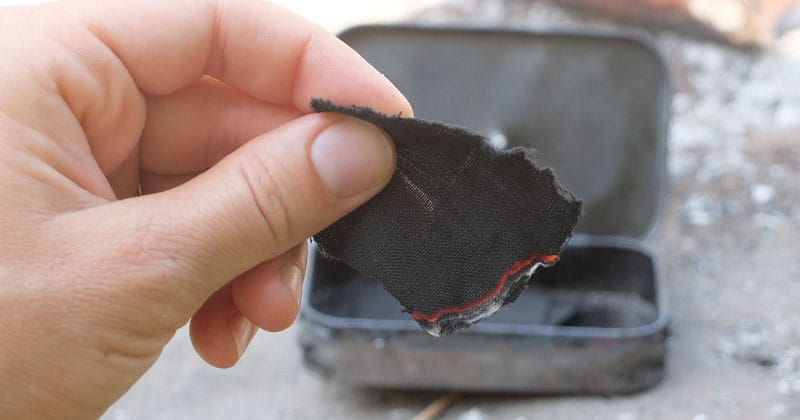
With almost all of these methods, you only get a small spark. At best, you get a tiny ember that dies out quickly. It is challenging to make a fire from just a spark or ember!
To succeed, you will need to have good tinder ready. Ideally, you have a char cloth with you. Char cloth can be ignited with a single spark, even at lower temperatures. Then, it is used to ignite tinder.
Read:
Friction Methods
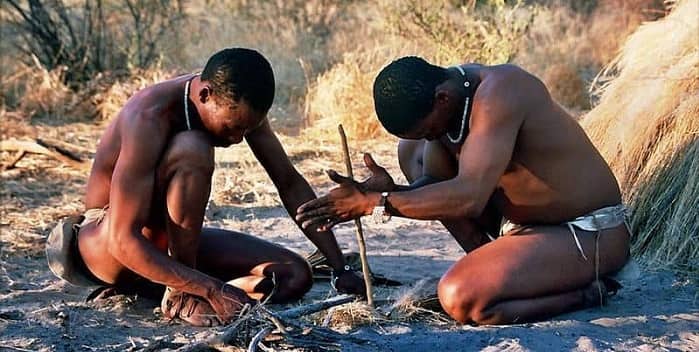
Most of the ways to make a fire without lighters rely on friction. You’ve probably seen it done in movies. They make it seem as easy as banging two rocks together.
Friction fire-starting is relatively simple but is very labor-intensive. Don’t expect it to be as easy as you saw on TV!
Instead of just rubbing two sticks together or banging rocks, you’ll have more success using one of the methods below.
1. Hand Drill
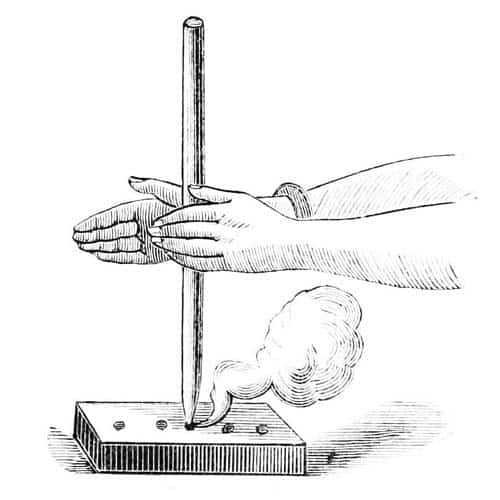
The hand drill is the most basic of the friction fire-starting methods.
You will need a baseboard, such as a larger branch or even the top of a tree stump to make it work. And you will also need an arm-length stick.
Here is what you do:
- Make a notch in your baseboard. The notch should be just big enough to fit your stick.
- Squeeze the stick into the notch.
- Put your tinder next to the notch.
- Spin the stick back and forth in the notch using your hands and a lot of downward force.
- Sparks should start to appear, and these sparks will light your tinder.
- Blow on the tinder to get the sparks to form a flame.
2. String or Bow Drill
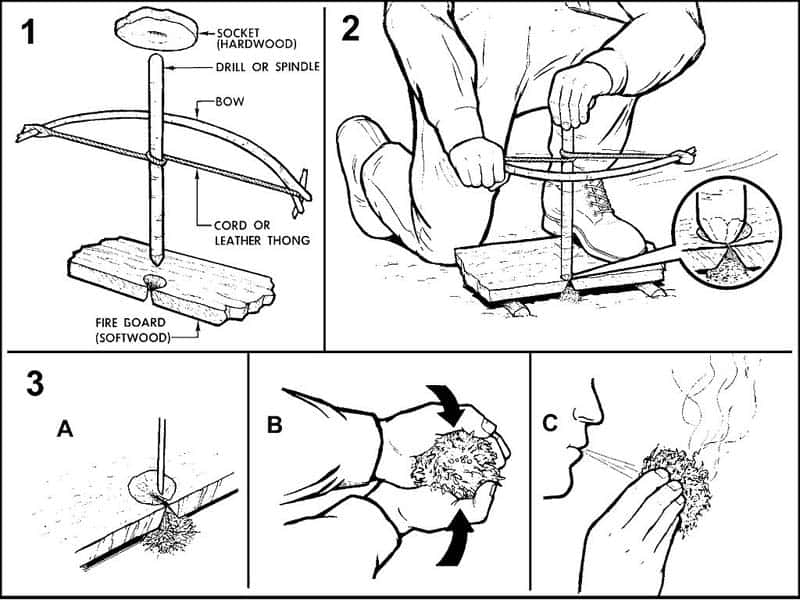
This method works in the same way as the hand drill. The difference is that you use a piece of string or rope (like your shoelace or paracord) to rotate the stick.
There are a couple of ways to make your drill. One is to create a “bow” and twist the stick into it. Then, when you pull the bow, it will cause the shaft to rotate.
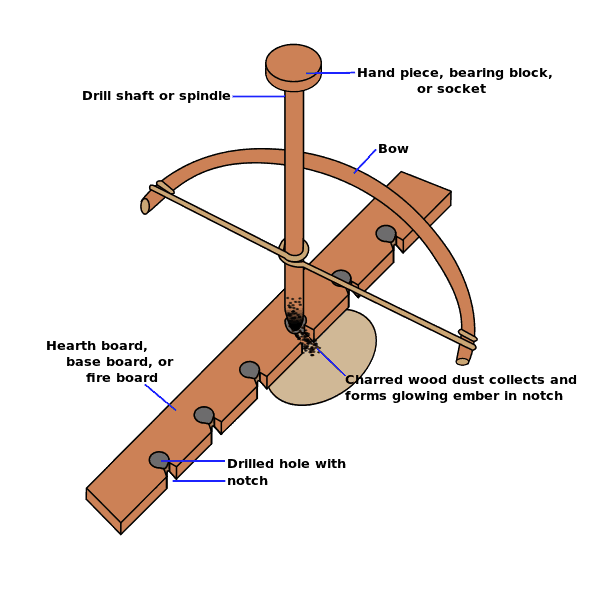
3. Fire Plough
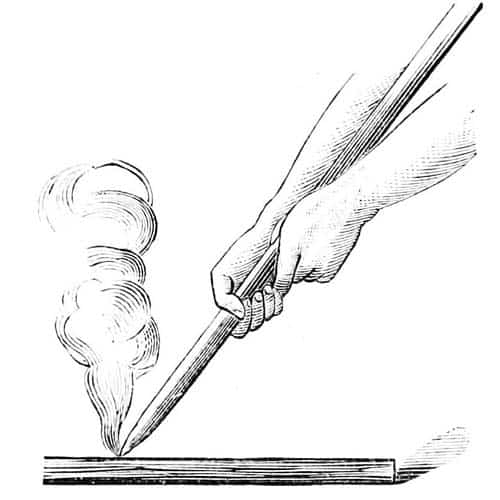
Instead of rotating the stick to create friction, you can rub it back and forth in a fire plough (also called a fire plow).
To make a fire plow, you need a board with a groove going down its length. The groove is necessary for catching sparks and embers.
You cut a second stick to a dull point. Then, you rub the stick up and down the groove. This produces friction as well as little pieces of wood dust that ignite. Once you’ve got enough lit dust in the groove, you can put it on your tinder.
4. Rudiger Roll Method (Fire Roll)
This is a personal favorite of mine. Legend has it that prisoners invented this method of starting a fire in WWII to light their cigarettes.
Here’s how it works:
- Use a flattened piece of flammable fibrous material, such as cotton, jute, or hemp.
- Lay the material onto a flat surface.
- Cover it with ashes, rust, tobacco, or even the contents of oxygen absorber packs. This is to create more friction and act as an accelerant. You can do it with the fiber material, but it will require much more friction.
- Roll the material up.
- Press a flat item on top (like a board) to roll it very tightly.
Then use the board to roll the bundle back/forth rapidly. It should start smoldering very quickly.
5. Flint and Steel
A flint and steel are some of the most primitive methods of starting fires without matches. It consists of two parts: A steel that gets struck against a flint.
The Flint:
Flint is a harder form of the mineral quartz. It has a hardness of about 6. Hardness is important. If you try to use a softer rock, it won’t be hard enough to shave away the steel pieces.
If you can’t find flint, you can also use:
- Chert
- Jasper
- Quartz
- Obsidian
- Granite
- Agate
Tip:
Any stone that scratches glass is probably hard enough to make sparks.
The Steel:
Before steel was invented, people used iron pyrite to strike against flint. Today, you can buy cool stuff like steel strikers for fire making.
Good fire steels are made from high-carbon steel treated to an ideal hardness. They will give off millions of sparks when hit.
However, it is possible to improvise a steel striker. A good survival knife will work. So will things like an old shop file. These will work, but they won’t produce as many sparks as a fire steel.
How Flint and Steels Work in Fire Starting
A flint and steelworks for fire starting because the flint is harder than the steel.
When you hit the flint with the steel, it causes little iron pieces from the steel to curl off. The friction and exposure to air cause the iron to ignite. These are the sparks you see.
Thus, the steel starts the fire, not the flint (even though it is the flint you see chipping away).
Here’s a quality flint and steel fire starting set with a stylish leather pouch on Amazon.
6. Ferro Rod Striker
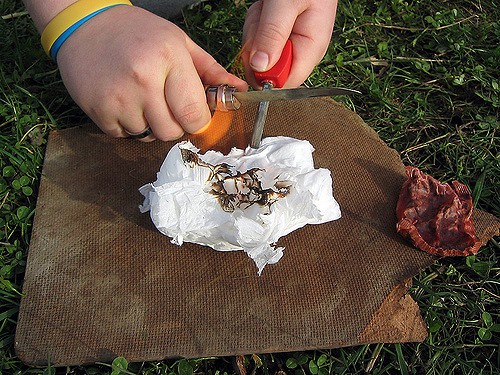
A Ferro (short for ferrocerium) rod works like a flint and steel. However, they are entirely different things. A Ferro rod is made of a unique material that gets VERY HOT when struck.
It will produce sparks that are in the 5,400F range. Compare this to the 800F sparks made by flint and steel.
The higher temperature makes starting a fire with a Ferro rod much easier than with flint and steel. A Ferro rod is much better if you carry a striker around for survival purposes.
We love this Uberleben Ferro Rod on Amazon.
Read: How to Use a Ferro Rod: Expert Tips
7. Using an Empty Lighter to Start a Fire
You brought a lighter along, but it ran out of fuel? You can still use it to start a fire.
This falls under the friction methods of fire starting because there is a tiny flint inside the lighter (often ferrocerium, technically not a flint). The flint supplies material for the sparks when you spin the spark wheel.
Here’s how to do it:
- Remove the lighter’s metal safety guard.
- Hold the lighter upside down over tinder.
- Gently spine the spark wheel. You do NOT want to make sparks.
- Little pieces of ferrocerium will fall onto your tinder.
- When you have a good pile of Ferro shavings (after about 2 minutes), you can spark the lighter next to them. They will ignite!
Note that the Ferro shavings will only stay lit for a fraction of a second. You must have your tinder ready to catch the flame!
Tip:
If it is a Bic-style lighter, you can use your survival knife to shave little pieces of plastic from the lighter case. These are great tinder.
Solar Methods
These methods of starting a fire without a lighter only work during the day and when the sun is powerful.
In real-life survival situations, you probably aren’t going to get that lucky. Night might fall before you realize you need to start a fire. It rains. Or there are simply too many trees around.
Still, you can plan ahead if you know you must make a fire and don’t have any matches or a lighter. When you get some good sun, use it to make a fire and then use a torch to carry embers.
8. The Magnifying Glass in Your Compass
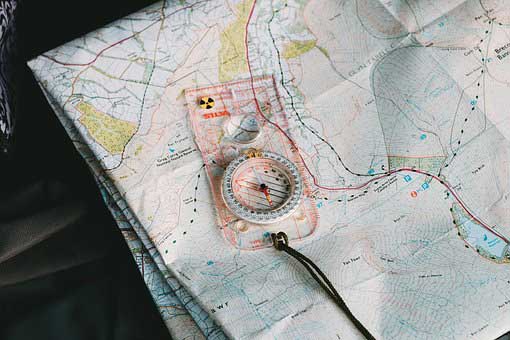
Most of us don’t carry a magnifying glass anywhere, especially in nature. However, your compass might have a magnifying glass on it. You can use this to create a fire on sunny days.
It is (almost) as easy as they show in movies. Just focus the light on some tinder and hold your hand very steady. In just a few minutes, the tinder will ignite.
This type of magnifier on Amazon would work well.
9. Sandwich Bag Filled with Water
You might have heard of this trick for making a fire without matches. Yes, it does work (and is damn cool).
What you do is fill a clear sandwich bag with water. Then, squeeze the bag to have a sphere shape filled with water. Now you have two curved sides (biconvex), which together will capture and focus light.
Essentially, you’ve just created a magnifying glass.
The video below shows how well this works in bright sunlight.
*You can also use a water bottle filled with water, but it won’t be nearly as effective as the sphere shape created by a plastic baggie.
10. Eye Glasses
This is another method that you always see in movies and TV. As you’d expect, it doesn’t usually work in real life. Most eyeglasses simply don’t focus light enough to produce a fire.
Here’s what you need to know:
It only works if you are farsighted.
Glasses work by bending the light before it reaches your eyes. If you are nearsighted, glasses bend the light further away from your eyes. Thus, nearsighted glasses will disperse sunlight instead of focusing it.
If you are farsighted, your glasses will focus the light closer. So, they will condense sunlight and can be used for starting a fire.
Put a drop of water on the glasses lens.
Unlike magnifying glasses, your eyeglasses are not biconvex (curved in both directions). So, eyeglasses will only bend the light one time.
This means that most eyeglasses won’t condense the light enough to create a fire – especially if you don’t have something like a char cloth to ignite.
However, putting a drop of water onto the middle of the lens will bend the light so it focuses more, creating a much stronger beam of light.
Or double the lenses.
Another way to make the eyeglasses fire work is to double the lens. Simply break the glasses and put one lens on top of the other. The video shows this will increase the lens’s focus, so the sunlight is concentrated into a more powerful beam.
You now have broken glasses, so it’s not the best solution if you need them to see. Maybe you’ll be lucky, and two group members will wear glasses that you can layer on top of each other.
11. Mirror
Some beauty mirrors curve inwards (concave), meaning they can focus sunlight into a tight, hot beam. Firefighters even warned that people shouldn’t keep these mirrors near windows because of the risk of fires.
However, starting a fire with a flat mirror is much more challenging. Pointing the light beam to get the area hot would take a long time. The earth would have rotated by then, meaning the light beam would slightly change position – and thus, the same spot wouldn’t be heating up anymore.
You’ll have to create a parabolic mirror to make a fire with a mirror. This leads us to #12…
12. Parabolas for Starting a Fire
Without getting into the complex mathematics of parabolas, a parabola is a deep concave dish. Parabolas are good at concentrating light onto a surface when made from a reflective material.
It’s pretty easy to make a parabola. You can even find one in nature (thanks to a-holes who leave trash everywhere).
For example:
- The reflector in your flashlight
- Polish The bottom of a soda can with toothpaste or something similar
- A Mylar space blanket shaped into a parabola shape
Interestingly, the Olympic Flame is lit by a parabola.
The video below shows just how well it works.
Using Everyday Objects to Light a Fire
Here are some ways to make a fire without matches that are truly MacGyver-esque.
Also, read some more ways to start a fire with household items.
13. Battery and Gum Wrapper
One cool trick you can use is a battery to start a fire. Note that doing this will drain the battery, so don’t do this if you need the battery!
You will need a battery and something which is metal but can ignite. Steel wool is the best option, but not everyone has it lying around. A gum wrapper also works well and is probably easier to find.
Take your steel wool (or metal gum wrapper cut into a thin strip) and touch it to both ends of the battery. A spark will form instantly and ignite the steel wool. Quickly use this to light your tinder.
If the steel wool doesn’t light immediately, you can create sparks by rubbing the steel wool on the battery ends.
It will cause current to go through the wires and heat them until they ignite.
You can also take a piece of metal, like a paperclip, and rub it against both ends of a battery simultaneously. Sparks will form and can be used to light tinder.
14. Fire Piston/Fire Syringe
A fire piston is an airtight cylinder with a plunger in it. When you push down on the plunger, it creates a considerable amount of pressure. The pressure produces heat, which can be transferred to tinder.
There are a bunch of different ways to make fire pistons at home. You don’t even need any unique materials. So, you could build one of these in a SHTF situation where you run out of lighter fluid.
Below is a video showing how to make a mini DIY fire piston. There are many other ways to do it, so check out other videos and tutorials.
Also, see our picks for the best fire pistons available to buy.
15. Instant Cold Pack, Zinc Powder, Salt, and Water
Have you got an instant cold pack in your first aid kit? Then, you can use it to start a fire.
Cold packs contain the chemical ammonium nitrate. Combined with zinc, salt, and water, it will ignite to make a fire.
So, where the heck do you get zinc? Yes, powdered zinc can be ordered online, but chances are you won’t have zinc lying around in a SHTF situation. Instead, you can scrape the greenish part off of a galvanized pipe.
Here are the instructions:
- Open the cold pack and remove the bag of ammonium nitrate.
- Grind up the ammonium nitrate.
- Combine ½ tsp. of ammonium nitrate with 1tsp powdered zinc and a small pinch of table salt.
- Put the mixture on a cotton ball or other tinder.
- Carefully put 1 drop of water on the mixture. Wait, and it will produce a green flame!
Disclaimer & Safety notes
- Try this at your own risk! I assume no responsibility for injuries!
- If you try this, do it outside.
- When obtaining scrapings of zinc, wear a face mask so you don’t inhale the zinc dust.
- Wear gloves. Your sweat can ignite the powder on your hands!!!
- Once the powders are mixed, be careful not to get them mixed. It only takes a small amount of water to ignite this.
- The mixture cannot be stored. Moisture from the air could cause it to ignite.
Using Chemistry
If you are good at chemistry, there are many ways to start a fire without matches using chemicals you can extract from household items.
However, most of these are not practical for survival situations. You’d have to be an outstanding chemist to know how to extract the chemicals and what ratios to use.
Plus, there is a risk of explosion and toxic fumes. In short, I’m listing these for educational purposes, but don’t expect anyone to employ them.
If you do try them out, be cautious!!! I assume no responsibility for injuries or damages! 😀
16. Potassium Permanganate and Glycerin
Potassium permanganate (or PP) is a chemical with surprising survival uses, such as purifying water and treating wounds. So, it is a good thing to keep in your emergency supplies kit.
You can buy PP in hardware stores in the area for water softeners (since it is used to remove iron from water). You can sometimes find it in pet stores since it treats fungi and bacteria in aquariums.
It can also be used for starting a fire without matches.
All you need to do is pour liquid glycerin over powdered PP. Wait a bit (it can take up to a minute for the reaction to occur), and the mixture will ignite into flames.
17. Potassium Permanganate and Battery Acid
If you don’t have glycerin to mix with PP, you can use battery acid instead. Battery acid is just diluted sulfuric acid. You can concentrate it from battery acid.
As explained here, dip a long wand into the sulfuric acid. Then (while standing as far back as possible!), use it to touch potassium permanganate crystals sprinkled on a cotton ball. It only takes a few seconds for the PP to be lit.
The reaction can be violent, so be cautious if you try this.
18. Chlorine and Brake Fluid
For this to work, you generally need highly concentrated chlorine, for example, chlorine pool tablets. When you combine the chlorine with brake fluid, it makes a huge fireball. Yes, this is explosive and should never be done indoors. You can read more on why it works here. The video below shows the reaction.
19. Sulfuric acid with Potassium Chlorate and Sugar
Here’s another super scientific way to make a fire without matches that you will probably never do in real life.
First, you’ve got to get sulfuric acid, which will probably be sourced from battery acid (see #17). Then you’ve got to get potassium chlorate, which is a bit more complicated but still possible to make at home from bleach.
Now all you have to do is:
- Mix equal amounts of potassium chlorate and sugar
- Add two drops of sulfuric acid to the mixture.
- Wait a bit, and you’ll soon see purpose flames!
Have you ever tried any of these methods? Any other ways of making a fire without matches or a lighter that I missed? Let us know in the comments!
Related: Make sure you know all the different types of lighters.
Fire Drilling, Wellcome Images, Creative Commons Attribution 4.0 International
Bow Drill, Hirsutism, CC BY 3.0
Magnesium Sparks, Hiroaki Nakamura, CC BY-SA 3.0
“3. Tinder alight” (CC BY-NC-ND 2.0) by coconinoco
US Air Force: Tech. Sgt. Bennie J. Davis III





Creek Stewart covered all these methods on his various survival shows, especially Fat Guys in the Woods. Amazing information to post. Thank you!
Great and comprehensive article! Thank you.
What about the other aspects of fire making? Especially when it is raining or wet wood etc. In other words in not-so-optimal conditions.
I looked around on the internet but not too much there. There is a very good course but it is in California and I am in Toronto, Canada. I would not mind taking a course either.
I love making a fire in the rain 🙂 Here are instructions for that (and there’s a video in the link too): https://momgoescamping.com/make-fire-rain/
Hi there how make bellow if you know what to do you can make it from a indoor antena just cut off at the base and top and you have a diy bellow with is lite
Thanks for all of these good ideas in one place.
Sincerely,.
Bill Getson
Thoughts I had after posting. . .
Three is two, two is one and one is none. Carry backups and separate them in BOB and on your person. Keep your EDC kit on your hip even though your BOB is on your back. Baggies are your friend – waterproof everything that won’t dry after soaking.
Watch some videos on building fires and making bird nests. Practice makes perfect but knowledge can improve and shorten practice sessions.
Use the match candles before you use the lighter (don’t throw that spark wheel away when the Butane is gone either – see #3. Get half a dozen of those striker surfaces from match boxes, put each in its own, small, double zip lock baggie and put them in a larger double zip lock baggie – they’re GOLD! You might also want to split them up between BOB, EDC and wallet.
Carry a wallet sized, 4x Fresnel lens in purse or wallet. This will never go bad or get used up and should be your primary fire starter for either bird nest or char tin unless it’s overcast. Use DARK materials like ground bark/pine cones/etc. White reflects light. You’ll find them on eBay for about five bucks.
Carry a shortened plastic straw in your char tin or in your possibles pouch to use on your burning char like the bellows of a forge – your best bet for getting wet tinder to burn.
Some genius tips there sir. Thanks for sharing your knowledge, love the plastic straw idea to use as a bellow.
Remember: VERSATILITY !
Yes a plastic straw can help, but a reusable metal writing pen is not only a pen, but has the VERSATILITY of also being a Bellows, a straw, a weapon…etc.
KNOWLEDGE creates CONFIDENCE and COMFORT !
Fire:
1. Carry a Bic lighter in your pocket or purse – never use it except in life threatening emergencies.
2. Carry a half a dozen match candles in your edc and another 25 or more in your BOB
https://www.youtube.com/watch?v=pLPplP9QEoc
I fold a square of toilet tissue in half, roll it around the match and secure it with dental floss before dipping in melted wax.
3. Ever work a forge? Me neither but I’ve watched videos and it’s pretty cool. I don’t like char cloth because it requires cloth (use washcloths/towels or jeans material for best charcloth) and there is a better way. Keep a fire kit in your BOB that uses flint & steel for everyday use. Along with that, carry a tin of renewable char MATERIAL. Here’s a video showing how. . . https://www.youtube.com/watch?v=FYEnrbZWMaU
P.R.,
I’d recommend some ‘RE-LIGHTING’ birthday candles.(read warnings) ⚠️
p.s. store them in a waterproof match holder with a few ‘strike-anywhere’ matches. <$5 @ W/M.
Hand drill materials must rub off enough soft powder to accumulate around the drill head so that the frictional heat will form a coal or ember.Only appropriate materials will do this.
Have tried doing hand drill before. Didnt work for me. Maybe im the problem. Just stick on using roadeavour flint and steel.
Yeah – hand drill takes some practice to master. Other methods easier for sure.